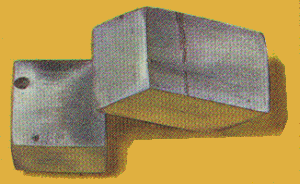 SKC Films Library SKC Films Library |
|
|
| SKC Films Library >> Science >> Chemistry >> Chemical Elements |
| Calcium (Ca) one of the most important elements on Earth
Properties atomic number 20 melting point 839° C Calcium reacts readily with both oxygen and water. Occurence and Sources Calcium makes up about 3½ per cent of the Earth's crust, making it the fifth most abundant element. It is only found in compounds, with calcium chloride, calcium carbonate, calcium fluoride, and calcium sulfate being the most common. Pure calcium metal, used in certain kinds of alloys, is obtained from molten calcium chloride through a process called electrolysis. Uses Various industrial processes, such as leather tanning and petroleum refining, involve calcium oxide. Calcium fluoride and calcium sulfate are used in making cement and plaster for construction work. Manufacturers use other calcium compounds in a wide variety of products ranging from fertilizer to paint. Calcium is essential to all living things, especially human beings and other animals. It is vital for the growth and maintenance of the bones and teeth, and it helps the blood to clot and the muscles to contract. History Sir Humphry Davy first isolated calcium as a pure metal in 1808. However, the ancient Egyptians, Greeks, and Romans knew about calcium compounds and used them to make mortar. The name calcium comes from calx, or lime (an oxide of calcium). SEE ALSO |
| SKC Films Library
>> Science >> Chemistry >> Chemical Elements This page was last updated on 04/14/2017. |
